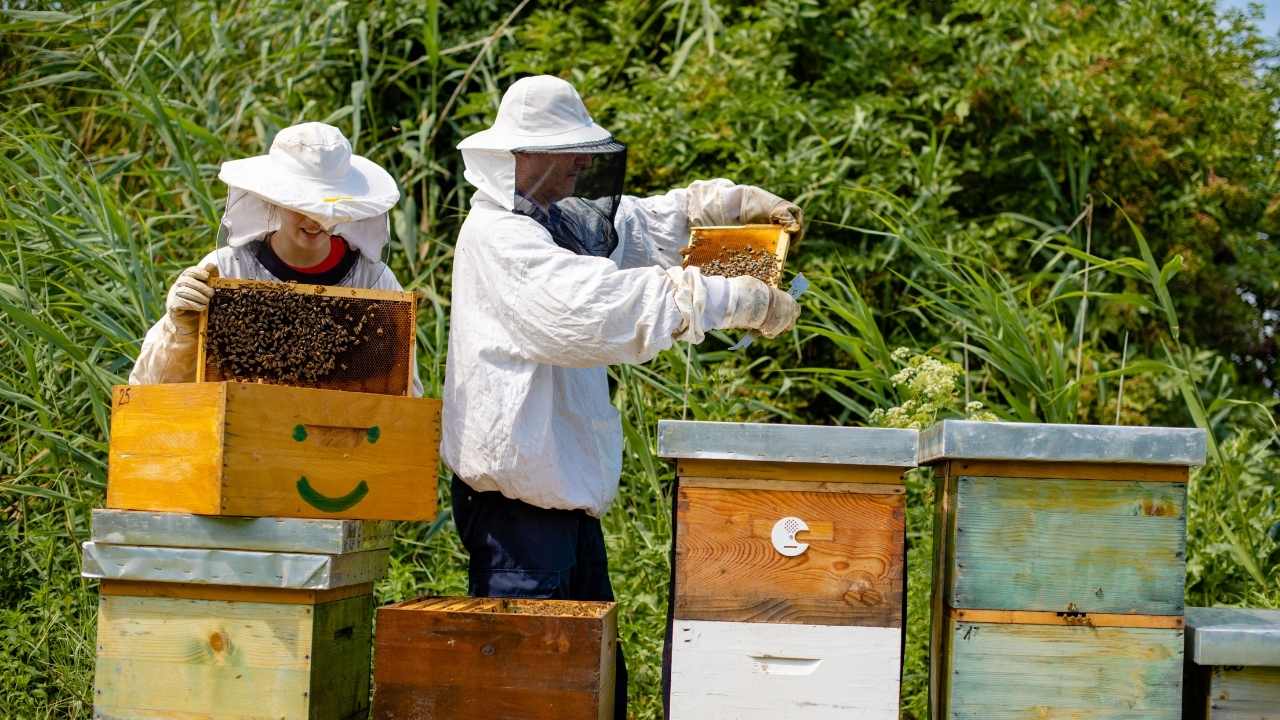
Are you ready to become a master beekeeper? Hive Five! is your ultimate guide to mastering the art of hive inspection, pest control, and honey harvesting. Whether you are a seasoned beekeeper or just starting out, this article will provide you with the knowledge and techniques needed to succeed in beekeeping.
Beekeeping is not only a rewarding hobby but also an important practice for our ecosystem. As bees pollinate plants, they contribute to the growth of fruits, vegetables, and flowers that we rely on for food and aesthetics. With Hive Five!, you can learn how to properly care for your honeybees while also reaping the benefits of fresh honey. So grab your suit and smoker, it’s time to dive into the fascinating world of beekeeping!
The Basics of Beekeeping
You’re about to embark on a journey into the fascinating world of beekeeping, where you’ll learn all the basics and get your hands dirty with sweet, sticky honey. First things first, you need to gather some essential beekeeping equipment such as a hive tool, smoker, protective gear like a hat and gloves, and of course, bees! Before you begin, make sure to familiarize yourself with any local beekeeping regulations in your area.
Beekeeping is an exciting hobby that requires patience and dedication. It’s important to keep regular checks on your hive for signs of disease or pests that can harm your colony. By doing so, you’ll ensure the health and safety of both bees and humans alike. Now that you have all the necessary equipment and knowledge about regulations let’s move onto the next step – hive inspection.
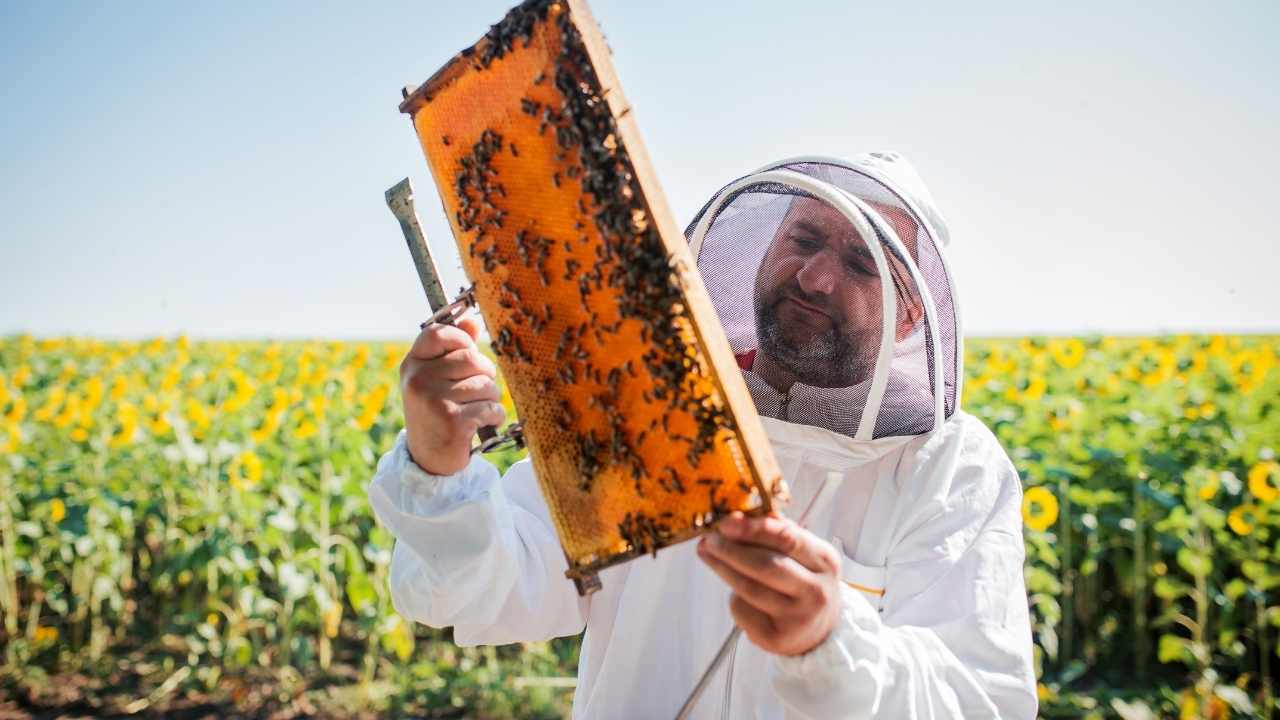
Hive Inspection
It’s like peeling back the layers of a blooming flower, each petal revealing something new and beautiful as you delve deeper into the heart of the matter. This is what hive inspection is all about. As a beekeeper, you need to inspect your hive regularly to ensure that your bees are healthy and productive. To start with, you need to prepare yourself for the inspection by wearing protective gear and using smoking techniques. Smoking helps calm down the bees, making them less aggressive during inspection.
Once you have prepared yourself, it’s time to inspect your hive. The first thing you need to do is check the queen status. You can identify her by looking for her long body and distinctive pattern on her thorax. If she’s not present or there are signs of an unhealthy queen, then it’s time to take action. Additionally, inspecting for diseases such as foulbrood or pests like mites should be done carefully as well. These inspections give you an opportunity to assess how well your bees are doing and make necessary adjustments for their growth and productivity.
Inspecting your hives may reveal unwelcome visitors in form of pests that could harm your honeybees’ health; this makes pest control crucial in beekeeping management.
Pest Control
Now that we’ve ensured our bees are healthy and productive, let’s tackle the challenge of keeping those pesky pests at bay with effective pest control techniques. Integrated pest management is a crucial aspect of beekeeping, as it helps to prevent the spread of diseases and pests that can harm your hive. Some natural solutions for controlling pests include using essential oils such as thyme or peppermint, which have been shown to repel certain insects.
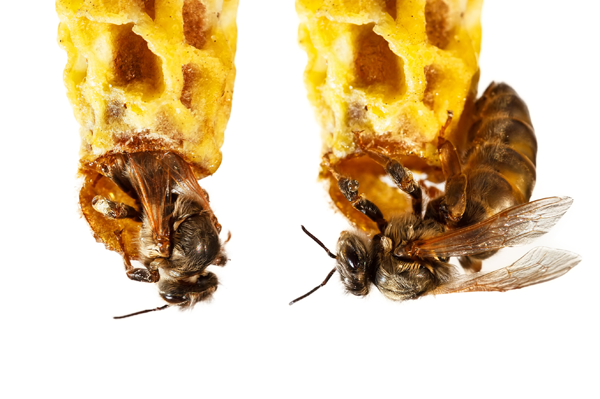
Another effective method is using screened bottom boards on your hive, which allow mites and other pests to fall through and out of the hive. Regular inspections and cleaning of your hives also help to prevent infestations from taking hold. Remember, prevention is key when it comes to pest control in beekeeping, so be sure to stay vigilant in monitoring for signs of infestation. Now, let’s move onto the sweetest part of beekeeping- honey harvesting!
Honey Harvesting
Let’s get ready to taste the sweet rewards of our hardworking bees by collecting the delicious golden liquid they’ve produced. Honey harvesting is a crucial step in beekeeping and requires careful planning and execution. The first step is to assess if your hive has enough honey reserves before harvesting. A good rule of thumb is to wait until at least 80% of the frames are capped with honey before extraction.
Once you’ve determined that it’s time to harvest, it’s important to use proper processing techniques for optimal results. There are two main methods for extracting honey: using an extractor or crushing and straining the combs manually. An extractor uses centrifugal force to separate honey from the comb, while manual crushing involves breaking open each frame and draining out the honey through a filter. Whichever method you choose, ensure that all equipment is clean and free from contaminants before starting the process. With these tips in mind, you’ll be able to enjoy fresh, delicious honey straight from your own hive!
As you progress as a beekeeper, there are advanced techniques that can help improve your colony’s health and productivity. One such technique includes re-queening regularly to maintain genetic diversity within your hive. Another technique involves rotating brood boxes between hives to prevent overcrowding and minimize swarming behavior. By implementing these advanced techniques along with proper pest control measures, you’ll be on your way towards becoming a successful beekeeper for years to come!

Advanced Beekeeping Techniques
If you want to take your beekeeping skills to the next level, you should consider learning about advanced techniques that can improve your colony’s health and productivity. Breeding programs and queen rearing are two examples of such techniques. By selectively breeding queens for desirable traits such as disease resistance, honey production, and gentle temperament, you can help ensure the long-term success of your colony.
In addition to breeding programs, rotating brood boxes is another technique that can benefit your bees. This involves swapping the position of brood boxes between colonies to encourage even distribution of resources and reduce swarming tendencies. Re-queening regularly is also important in maintaining a healthy hive as it helps prevent genetic issues from developing within the colony. By implementing these advanced beekeeping techniques, you can become a more successful and knowledgeable beekeeper, ultimately leading to happier and healthier bees. Now let’s move on to troubleshooting common beekeeping issues.
Troubleshooting Common Beekeeping Issues
As a beekeeper, you may encounter common issues that can affect the health and productivity of your colony. One such problem is queen problems. If your hive seems to be struggling with brood production or if you notice a lack of eggs, it could be due to an issue with the queen. The first step in troubleshooting this problem is to locate the queen and assess her health. Look for signs of illness or injury such as deformities, discoloration, or abnormal behavior. If there are no obvious issues with the queen but you still suspect she may not be performing adequately, consider requeening your colony.
Another common issue that beekeepers face is swarming. Swarming occurs when a large group of bees leave their hive in search of a new home. While it can be a natural process for bees, it can also lead to reduced honey production and potentially lost colonies for beekeepers. To prevent swarming, ensure that your hive has plenty of space by adding additional supers as needed. Regular inspections will also help you identify any potential swarming behaviors early on so that you can take action before it becomes an issue. Additionally, consider splitting your hives if they become too crowded as this can reduce the likelihood of swarming while also allowing you to grow your apiary through increased colony numbers.
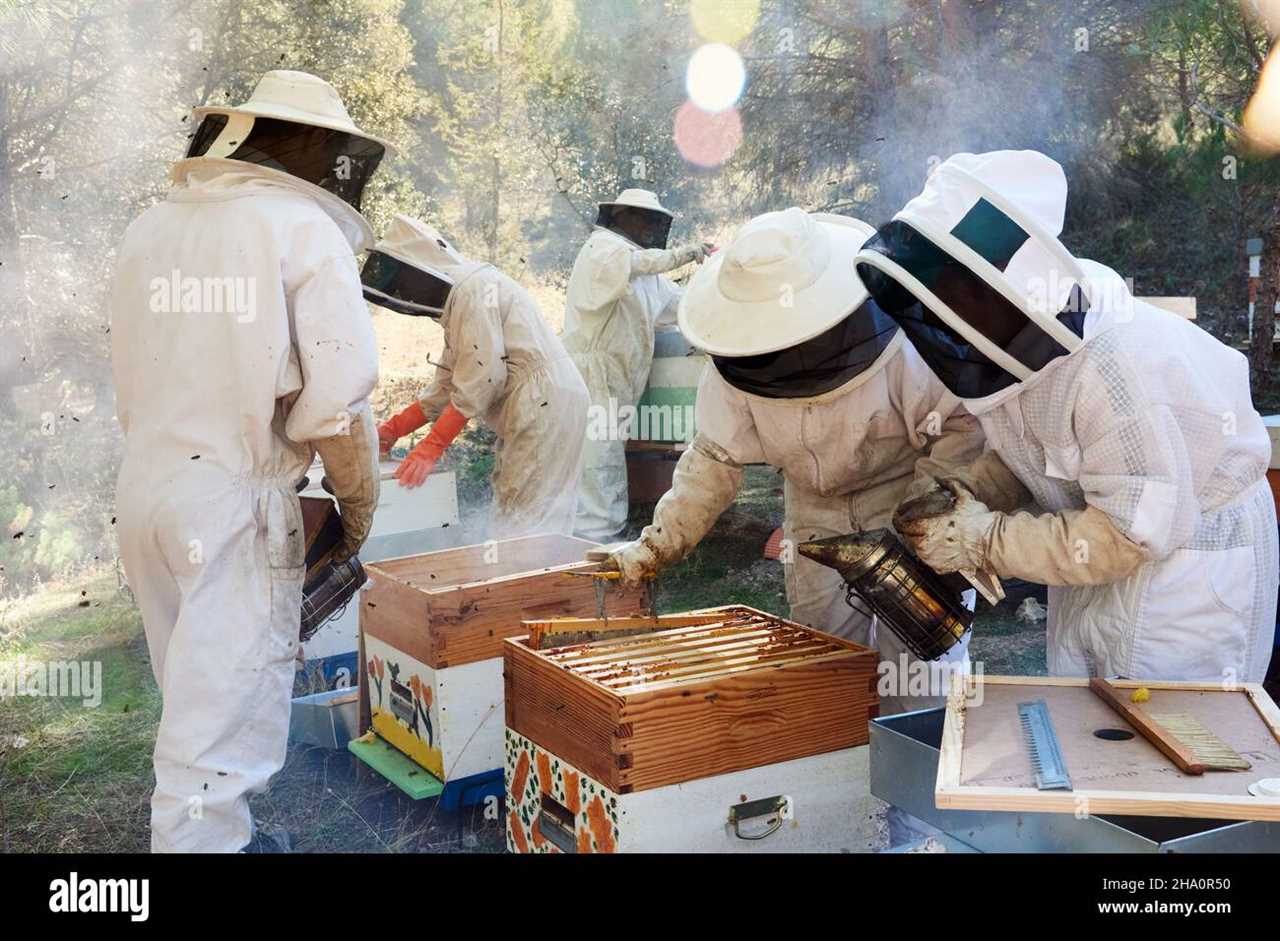
Frequently Asked Questions
How long can a queen bee live?
As the heart and soul of a honeybee colony, the queen bee plays a vital role in its survival. Queen bees can live up to five years, although their reproductive abilities typically decline after two to three years. The genetics of queen bees are also crucial for the health and productivity of the colony. A well-bred queen bee will pass on desirable traits to her offspring, such as disease resistance, gentle temperament, and efficient honey production. Regularly monitoring the health and behavior of your queen bee is essential for maintaining a thriving hive ecosystem. By understanding the intricacies of queen bee reproduction and genetics, you can ensure that your colony remains strong and productive for years to come.
What is the average lifespan of a worker bee?
As a beekeeper, you may wonder about the lifespan of your worker bees. On average, a worker bee will live for about 6 weeks during the active season. However, some workers may live up to 5 months during the winter when they are not as active. This is in stark contrast to the queen bee’s longevity, who can live up to 5 years! It’s important to keep track of your hive and regularly inspect it for any signs of disease or pests that could shorten the lifespan of your worker bees. By taking care of your hive and ensuring its health, you can help extend the lifespan of your hardworking bees and enjoy their sweet honey for years to come.
Can honey bees fly in the rain?
Rainy days are not the ideal weather for honey bees to fly. However, they are capable of flying in light rain or drizzle, but heavy rain can be a challenge even for them. Since their wings get wet and heavy in the rain, it becomes difficult for them to lift off from the ground. Additionally, when it’s raining, flowers tend to close up and produce less nectar, which affects honey production. This means that Rainy Day Bees might have a tough time finding food sources during such weather conditions. The Buzz on Weather and Honey Production suggests that while bees can survive rainy days by staying inside their hives, prolonged periods of rainy weather can affect their overall health and colony productivity.
How many bees are in a typical hive?
If you’re curious about the number of bees in a typical hive, you’ll be interested to know that there can be anywhere from 20,000 to 80,000 bees living in one colony. The population dynamics of a hive are fascinating, with worker bees performing various tasks such as caring for the young and collecting nectar and pollen. Interestingly, the behavior of the queen bee plays a crucial role in regulating the hive’s population. She determines how many eggs she lays each day, which affects the number of new bees being born. As you learn more about beekeeping and hive inspection, understanding these dynamics will help you maintain a healthy and balanced colony for optimal honey harvesting.
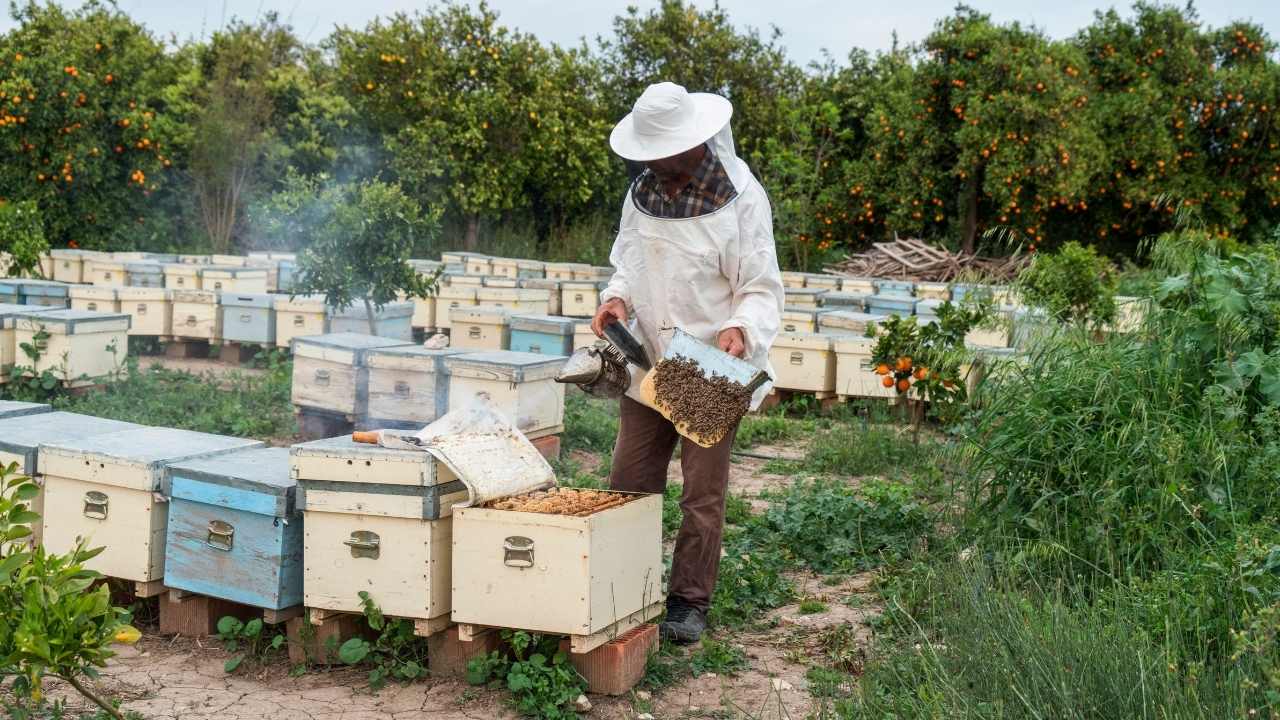
How do bees communicate with each other?
Did you know that bees have a unique way of communicating with each other? They use a combination of waggle dance and pheromone signals to convey information about food sources, potential threats, and even the location of their hive. The waggle dance involves the bee moving in a figure-eight pattern while waggling its abdomen. The direction and intensity of the waggling indicate the distance and quality of the food source. Meanwhile, pheromone signals are released by worker bees to signal danger or excitement. This communication system is so effective that it allows bees to work together as a cohesive unit, ensuring their survival as a colony. Understanding how bees communicate is essential for beekeepers who want to better understand their hives and take care of them properly.
Conclusion
Congratulations! With this article, you have learned the basics of beekeeping and how to master the art of hive inspection, pest control, and honey harvesting. You now have the knowledge to become a successful beekeeper!
But wait, there’s more! As an advanced beekeeper, you can continue your learning journey by exploring new techniques such as queen rearing and swarm prevention. Don’t be afraid to troubleshoot common issues like mite infestations or weak colonies.
Remember that beekeeping is not just about harvesting honey; it’s about caring for these important pollinators and ensuring their survival. By using your newfound knowledge in a responsible way, you can contribute to the health of our ecosystem.
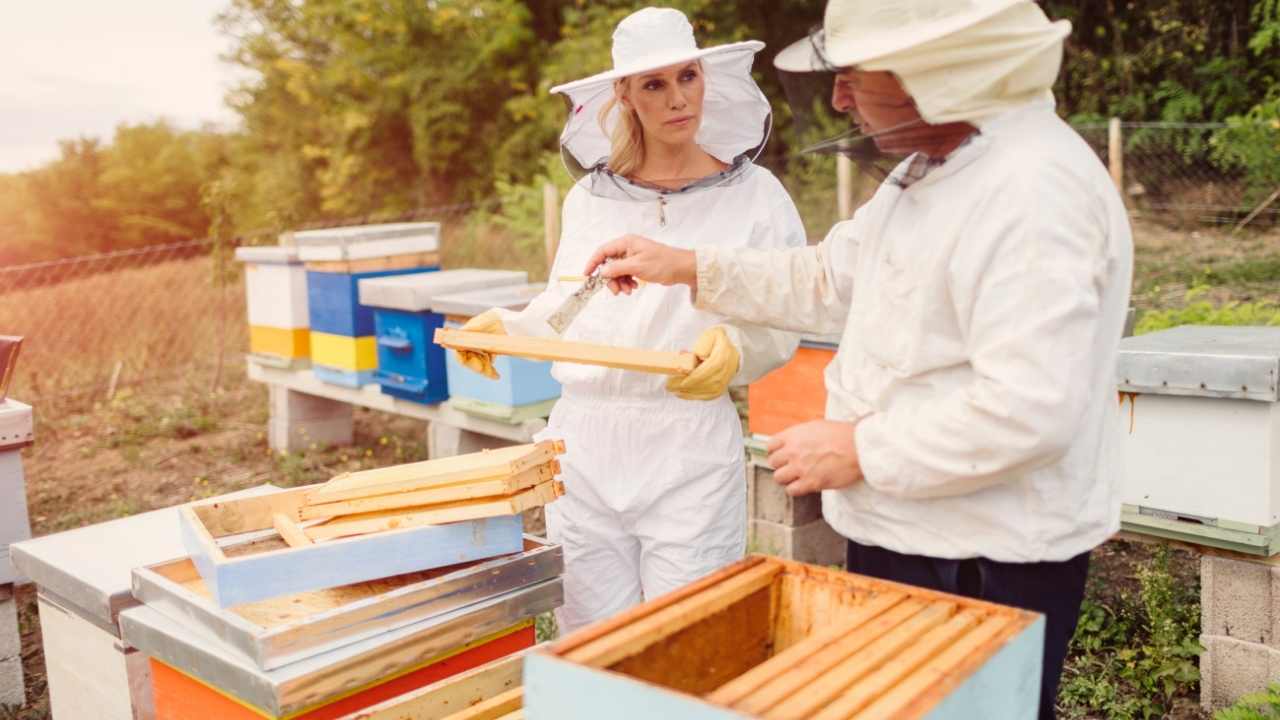
So go forth and start buzzing with excitement as you embark on this sweet adventure!

Roger Thomas is a seasoned beekeeper and hive architect with a deep-seated passion for sustainable living. His fascination with bees has shaped his professional career, giving him practical and theoretical expertise in bee behavior, colony health, and optimal hive conditions. Roger’s technical skills shine in his bespoke hive creations that cater to the specific needs of diverse bee species, while his sustainable practices promote environmental balance and the wellbeing of the bee population.
As he continues his journey in beekeeping, Roger has become a dedicated advocate for responsible practices and an insightful educator in his field. His posts aim to inspire new beekeepers, underline the importance of sustainability, and showcase the remarkable contribution bees make to our ecosystem. Roger invites you to join him as he delves into the world of bees and the rewarding, honey-sweet art of beekeeping.
